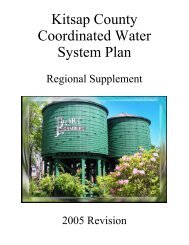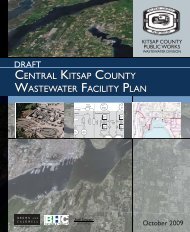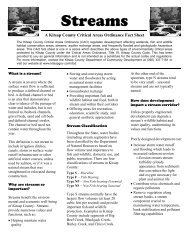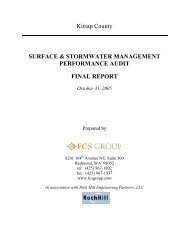2009 Kitsap County Budget Book - Kitsap County Government
2009 Kitsap County Budget Book - Kitsap County Government
2009 Kitsap County Budget Book - Kitsap County Government
Create successful ePaper yourself
Turn your PDF publications into a flip-book with our unique Google optimized e-Paper software.
JUVENILE SERVICES<br />
devoted to assessing needs, developing and administering the court’s Family and Juvenile Court Improvement Plan.<br />
Funding also provides for the training of the case coordinator.<br />
Truancy Intervention Program<br />
The role of the Juvenile Department in truancy cases is to monitor juveniles who are reported by the schools as truant, and<br />
assist them in the compliance of the requirement to attend school. Truancy interventionists meet with school officials and<br />
other collateral agencies involved in the case plan of the youth and family and recommend resources to support or<br />
accelerate a successful resolution of truancy issues.<br />
VI. Program Overview<br />
Program:<br />
Description:<br />
Initiatives:<br />
Detention<br />
The detention facility is a 24 hours per day/7 days per week facility which serves the needs and sanctions of<br />
criminal offenders and status offenders alike. The key components of the Detention Facility are:<br />
1. Secure Detention – houses all pre and post disposition juvenile criminal offenders in <strong>Kitsap</strong> <strong>County</strong>. Contracts<br />
have also been secured to “rent” bed space for like juvenile criminal offenders of Jefferson <strong>County</strong>; the<br />
Suquamish Tribe, Skokomish Tribe and the Port Gamble S’Klallam Tribe.<br />
2. Secure Crisis Residential Center (S-CRC - one pod that houses juveniles who are the subjects of law<br />
enforcement’s involvement due to runaway behavior; or juveniles placing themselves in circumstances that<br />
constitute a danger. Bed space is paid for by DSHS, whether or not the beds are occupied. This Center is jointly<br />
shared with Pierce <strong>County</strong> through an arrangement that was conceived in 2000. Note: S-CRC budget (CC<br />
9426) is separate from Detention budget (CC 9422).<br />
3. Alternatives to Detention Program – a multi-faceted program that has the following individual components:<br />
• Work Crew – juveniles who would otherwise be incarcerated at the Detention Facility are provided<br />
opportunities to perform non-paying community service work at various local private non-profit, public, and<br />
government agencies.<br />
• Electronic Home Monitoring (EHM) – juveniles who would otherwise be incarcerated at the Detention<br />
Facility are rigorously screened for acceptance of the electronic monitoring option, and an ankle bracelet is<br />
installed on the juvenile and monitored for compliance by a contractual company.<br />
• <strong>Kitsap</strong> Alternative Transitional School (KATS) – first opened its doors to students in 2003. Its mission<br />
has been to provide 220 day (day reporting) educational programming for students who are on a term of<br />
probation, and who have been either long-term suspended or expelled by their schools of origin. KATS has<br />
been successful at providing these learning opportunities to a population of students who have<br />
demonstrated significant behavioral and academic deficits to the point that no other local learning<br />
institutions are desirous of continuing these students’ enrollments. While the goal of providing a highly<br />
structured environment for these students continues to be accomplished, the predicted by-product of these<br />
efforts has been to negate the opening of a pod (a living unit of 12 detainees) in the south end of the<br />
Detention Building. Because of the 24/7 staffing costs necessary to do so (straight time salaries/benefits;<br />
and overtime “backfills” for staff trainings; and staff sick and annual leaves), the development and<br />
maintenance of the KATS program has proven itself to be a cost effective and viable alternative to<br />
incarceration.<br />
• Employment Development Program (EDP) – Juveniles who are on a term of probation are provided an<br />
opportunity to be paid to work at one of the county sites through an arrangement with the <strong>County</strong>’s Fair and<br />
Parks Department. The optimum desire (goal) is to be able to employ a consistent total of 12 participants<br />
throughout the year. A summertime program of six participants would maintain the core continuity of this<br />
program.<br />
1. Assess each juvenile offender’s need for secure incarceration versus placement into the Alternatives to<br />
Detention program.<br />
2. Continue utilization of the KATS program to eliminate the need to open one additional pod in the south end of the<br />
Detention Facility.<br />
3. Continue to promote the concept of the Employment Development Program, and provide highly qualified,<br />
screened, and trained juveniles for the available employment opportunities for this program.<br />
101

















